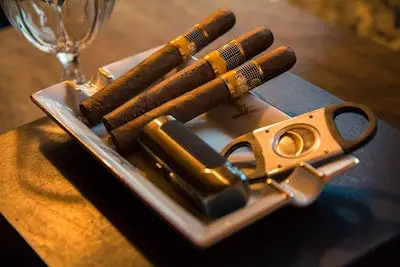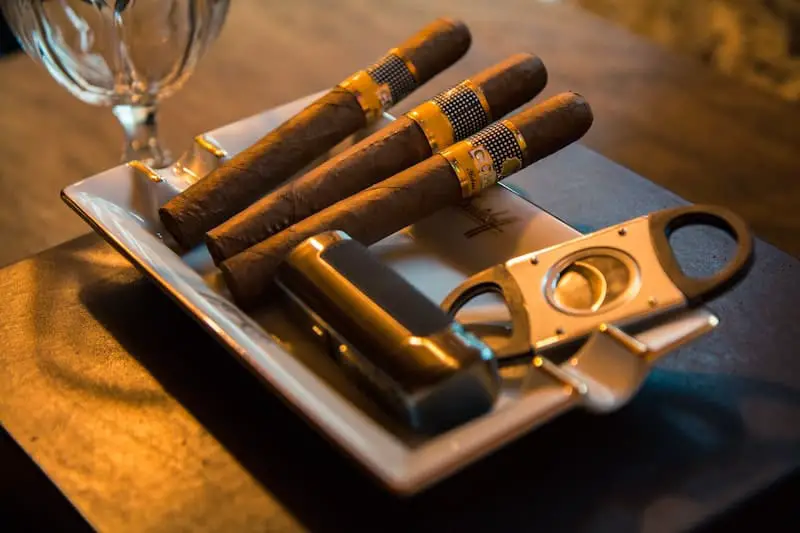Understanding How Cigars Get Their Flavor
Inspired by the intense specificity of cigar flavor, I began to wonder where these flavors originate and how exactly they are formed. So, I did some research to find out where cigars get their flavor.
So, where do cigars get their flavor? There is no single origin for cigar flavor, but rather a complex combination of variables that, when shifted, are responsible for imparting flavor to a cigar. These variables include but are not limited to growing conditions like soil and climate as well as the processing techniques after the fact.
Of extremely high importance, cigar flavor can make or break the cigar smoking experience. Because many cigar smokers only smoke occasionally, there is no room for compromise when choosing cigars. From an experienced cigar lover to a smoker that is brand new to the cigar scene, a familiarity with cigars is a key element to finding success in the search for fine cigars. Premium, well-made cigars make a great gift for your best friend or even an excellent addition to your rehearsal dinner!
What Impacts a Cigar’s Flavor
 Just like a bottle of wine or a specific type of coffee, cigars have an origin that is responsible for their flavor. For example, a cigar from Cuba may have a totally different flavor than a cigar whose tobacco was grown further north in the United States. Not only will the major climate differences play an important role in the development of the tobacco’s flavors, but the soil will have differences as well. These soil differences, such as acidity and nutrients, may sound like minutia but will play a major part in developing the tobacco.
Just like a bottle of wine or a specific type of coffee, cigars have an origin that is responsible for their flavor. For example, a cigar from Cuba may have a totally different flavor than a cigar whose tobacco was grown further north in the United States. Not only will the major climate differences play an important role in the development of the tobacco’s flavors, but the soil will have differences as well. These soil differences, such as acidity and nutrients, may sound like minutia but will play a major part in developing the tobacco.
Soil Composition
Soil make-up is key to the cigar flavor. Elements and minerals in the soil such as magnesium, nitrogen, calcium, iron, and many others will all be factors in the way the tobacco grows, the flavors it develops along the way, and the overall health of the crop. So, not only do varying degrees of each element and mineral change the way the tobacco grows, but they also will alter the final flavor of the tobacco.
Beyond the tobacco growing process, many other variables are playing into a cigar’s flavor. For example, nearly every step a tobacco leaf takes after it grows will alter the final product. From the time the plant is harvested to the way the tobacco is aged, every single element is crucial to creating a premium cigar. So much so, that even the wrapper will play a role in the taste and experience of the cigar.
Cigar makers alter the taste of cigars by choosing specific tobaccos from different regions, blending certain tobaccos to create custom flavor profiles, as well as experimenting with the fermentation and aging process of the tobacco. By adjusting these variables, the cigar makers can alter the sweetness, spiciness, bitterness, and overall smoothness of the cigar smoking experience.
Anatomy of a Cigar
A cigar’s anatomy is comprised of three main parts. The filler, the binder, and the wrapper. These names are pretty self-explanatory. However, understanding the anatomy of a cigar one of the things every cigar smoker should know. The filler is exactly what it sounds like. It fills the cigar. The filler is typically made of broken or small pieces of tobacco leaves and packs the center of the cigar. After the filler comes the binder, which is essentially the inside wrapper. The binder is still composed mainly of whole tobacco leaves. Because they are wrapped inside the outer wrapper, imperfect leaves are often chosen for this layer.
The outside wrapper of the cigar is the first thing consumers will notice, so this layer is going to be where the cigar maker showcases the finest cigar leaves. No imperfections must be visible on the outside of the cigar. Plus, the wrapper is a good indication of the quality of the tobacco used in the cigar. However, some cigars feature wrappers made from tobacco that is sourced in different places than the internal tobacco. This is done to alter the flavor and overall experience the cigar has to offer the smoker.
How Climate Impacts a Cigar
This may go without saying, but the region that a cigar’s tobacco is grown greatly affects the taste of the final product. For example, both smokers and nonsmokers are likely aware that Cuban cigars are generally hailed as the best of the best cigars. No doubt this has to do with the quality and experience of the Cuban cigar craftsmanship, but much of this acclaim has to do with the region the tobacco is grown in.
The smoking experience associated with a cigar comprised of only Cuban tobacco will likely differ greatly from the smoking experience of a cigar made up of tobacco from several different regions or even single-origin cigars from different regions. The main differences come as a result of temperature, humidity, sun exposure, rainfall, and various other factors.
Why are Cuban Cigars Better?
First of all, the tobacco used in Cuban cigars is typically a premium product. This alone makes a major difference in the overall quality of the cigar itself. Cuba is positioned in the Caribbean close to the equator and has a perfect climate for producing high-quality cigars. However, a good cigar is not a result of fine tobacco alone.
It takes high-quality craftsmanship and years of experience to know how to turn premium tobacco into an equally premium cigar. Luckily, experience is something Cuba is not short on. The county has been creating fine cigars for centuries after centuries.
Soil’s Effect On Cigar Quality
Have you ever fed a houseplant because it seemed to need a little assistance getting back to its healthy self? If so, you already have a grasp of soil’s impact on a cigar. The reason you have to feed a houseplant is to compensate for the depleted minerals and nutrients in the soil.
Just like humans, plants need a consistent supply of things like magnesium, nitrogen, calcium, and iron to stay healthy and grow to their full potential. The amount of these elements may prevent your ficus from looking its best. In the same way, the supply of these elements and minerals in the soil that grows tobacco will play a significant role in the flavors that the tobacco develops.
Just like the human body, plants require proper nutrition to grow and stay healthy. Plants growing in soil that is not nutrient-rich will suffer as a result. Some of this nutrient make-up can be altered with fertilizers and additives. However, a lot of it comes down to the original quality of the soil.
Processing Premium Cigars
To get from tobacco seed to cigar, there is a lengthy, involved journey that the tobacco farmer and cigar maker must make. Once the farmer grows and harvests the tobacco, it must go through an aging process called curing. In this process, the tobacco leaves dry out and lose their bright green coloring. Sometimes the tobacco is simply air-dried, while other makers prefer to dry the tobacco in a slightly heated barn. Many cigar makers will take advantage of this curing period to impart flavors on the tobacco using smoke and other practices.
Once the tobacco has been cured, it moves on to the fermentation process. This fermentation period can last anywhere from several months to a few years. It is responsible for major developments in flavor and aroma. Once the fermentation has taken place, the leaves are sorted and stripped of their vein. This is necessary to properly roll the tobacco for smoking. The stripped leaves are bunched into bales and ready to continue their journey toward becoming a cigar. The best place to experience a true premium cigar is a Claremore Cigar Bar.
Related Questions
Are cigars healthier than cigarettes? No. Cigars and cigarettes are both equally bad for your health as they both contain nicotine. The big difference between the two tobacco products is their make-up rather than their ingredients or health differences. A cigar actually has far higher nicotine content, as the entire construction of a cigar comes from tobacco.
The size difference obviously impacts the nicotine content, but the anatomy plays a major role as well. A cigarette is smaller, wrapped in paper, and includes a filter. The majority of cigarette smokers smoke enough cigarettes per day to equal the nicotine content of a cigar. The size difference does not change the fact that both are bad for your health. Smoking can also lead to excessive wrinkles around the mouth or face, necessitating wrinkle treatments after years of this habit.
How do you light a cigar? Cigar lighting is nothing like cigarette lighting and requires a bit more patience and practice. A properly lit cigar is evenly burning to pull flavors from all layers of the cigar. It can take a little bit of time to light one, but the result is worth the wait. To light a cigar, cut the end using a cutter. Use a flame to gently warm the end of the cigar without touching the flame to the cigar.
Turn the cigar as you warm it to evenly distribute the heat. Once the cigar is close to lighting, touch the unlit tip to your lips and draw the heat in multiple times.
Find more answers to life’s questions here.

